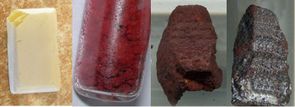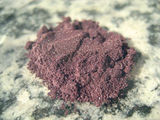Phosphorus
 White, red powder, red chunk and violet phosphorus (left to right). | |||||
| General properties | |||||
|---|---|---|---|---|---|
| Name, symbol | Phosphorus, P | ||||
| Allotropes | White, red, violet, black | ||||
| Appearance | Colorless or waxy white, yellow, scarlet, red, violet, black | ||||
| Phosphorus in the periodic table | |||||
| |||||
| Atomic number | 15 | ||||
| Standard atomic weight (Ar) | 30.973761998(5) | ||||
| Group, block | , p-block | ||||
| Period | period 3 | ||||
| Electron configuration | [Ne] 3s2 3p3 | ||||
per shell | 2, 8, 5 | ||||
| Physical properties | |||||
| White, yellow, scarlet, red, violet, black | |||||
| Phase | Solid | ||||
| Melting point |
317.25 K (44.1 °C, 111.38 °F) (white) 883.15-898.15 K (610-625 °C; 1130-1157 °F) (red) | ||||
| Boiling point | 553.15 K (280 °C, 536 °F) (white) | ||||
| Density near r.t. |
1.823 g/cm3 (white) 2.2–2.34 g/cm3 (red) 2.36 g/cm3 (violet) | ||||
| Heat of fusion | 0.66 kJ/mol (white) | ||||
| Heat of | 51.9 kJ/mol (white) | ||||
| Molar heat capacity | 23.824 J/(mol·K) (white) | ||||
| pressure (white) | |||||
| pressure (red) | |||||
| Atomic properties | |||||
| Oxidation states | 5, 4, 3, 2, 1, −1, −2, −3 (a mildly acidic oxide) | ||||
| Electronegativity | Pauling scale: 2.19 | ||||
| energies |
1st: 1011.8 kJ/mol 2nd: 1907 kJ/mol 3rd: 2914.1 kJ/mol | ||||
| Covalent radius | 107±3 pm | ||||
| Van der Waals radius | 180 pm | ||||
| Miscellanea | |||||
| Crystal structure | Body-centred cubic (bcc) | ||||
| Thermal conductivity |
0.236 W/(m·K) (white) 12.1 W/(m·K) (black) | ||||
| Magnetic ordering | Diamagnetic (white, red, violet, black) | ||||
| CAS Registry Number |
7723-14-0 (red) 12185-10-3 (white) | ||||
| History | |||||
| Discovery | Hennig Brand (1669) | ||||
Phosphorus is a chemical element with symbol P and atomic number 15. It is a solid nonmetal, consisting of two main allotrope forms, white and red. The white form is highly reactive in the atmosphere, while the other forms of phosphorus much less.
Contents
Properties
Chemical
White phosphorus reacts with air and can spontaneously ignite, if heated slightly, forming phosphorus pentoxide. Red phosphorus is much more stable in air, but will react with halogens.
Phosphorus chlorides, for example, are formed from the reaction of white phosphorus and chlorine gas
- P4 + 6 Cl2 → 4 PCl3
White phosphorus will react with nitric acid to produce phosphoric acid and nitrogen dioxide.
- P + 5 HNO3 → H2O + H3PO4 + 5 NO2
Physical
Phosphorus is solid at standard conditions and exhibits several allotrope forms:
- White phosphorus - also known as yellow phosphorus, WP or simply tetraphosphorus (P4) is a white waxy solid, that becomes yellow when exposed to light. When exposed to oxygen, it glows green in the dark, is extremely flammable and pyrophoric upon contact with air, and is very toxic, having the potential to cause morbidity and death through high enough exposures. It is almost always stored underwater to prevent ignition. White phosphorus is highly soluble in carbon disulfide and disulfur dichloride, soluble in anh. ammonia, ethanol, thionyl chloride, toluene, somewhat soluble in benzene and chloroform, and slightly soluble in acetone, carbon tetrachloride, diethyl ether, heptane, paraffin, anh. phosphine. Evaporation of these solutions yields scarlet-colored phosphorus.
- Red phosphorus - also called red P, is an amorphous red solid at standard conditions, and is considerably more stable than the white form. It is formed by heating white phosphorus to 250 °C in inert conditions. It is insoluble in all solvents, though it may react with some chemicals.
- Violet phosphorus - also known as monoclinic phosphorus, it is solid brown-violet. It is formed by heating red phosphorus in a sealed tube at 530 °C or white phosphorus at 500 °C in molten lead for 18 hours. Insoluble in all solvents, violet phosphorus has low reactivity and ignites in air at 300 °C.
- Black phosphorus - it is thermodynamically stable at standard conditions. The black form is obtained by heating white phosphorus under incredibly high pressures (12,000 atmospheres). It is similar to graphite in appearance and properties, as a flaky black solid that conducts electricity. It is the least reactive allotrope form.
- Diphosphorus - Unlike the other forms, it is gaseous. Diphosphorus can be obtained normally only under extreme conditions (from P4 at 1100 K). Is is only stable between 1200 °C - 2000 °C.
Only the first two forms are of importance to chemists, while violet and black phosphorus are mostly sought for element collection, due to their rarity.
White phosphorus is soluble in many organic solvents, whereas the other varieties are insoluble in any solvent.
Availability
Red phosphorus can be extracted from the striker strips found on match boxes, that consist of red phosphorus, ground glass and glue. The strips are soaked with acetone to remove the glue, then scraped from the sides. However, there are some types of striker strips that use a very strong adhesive which cannot be dissolved with acetone, and instead chloroform or dichloromethane should be used. As the scraped paste also contains ground glass and other impurities, purification is required. Red phosphorus is not soluble in any solvents, so the purification is a bit more complicated. One way to remove the glass is to add a solution of sodium hydroxide to dissolve the glass, although this will take some time. The resulting RP is filtered, collected and dried. This method however requires a large number of striker strips: a typical matchbox has between 0.005-0.05 g RP, depending on the type of matchbox, thus it takes around 200 matchboxes to obtain 1 g of RP). However, matchboxes with full surface striker strips have much more red P, in the case of large matchboxes, you may even get 0.1 g per striker strip.[1] It is much more efficient in the long run to invest in making your own phosphorus-producing apparatus to make white phosphorus. Buying huge amounts of matches is also likely to be noticed and attract attention, as it is something often done by drug manufacturers.
Legality
European Union
As of 2020, the sale of red phosphorus in the EU above 100 g requires registration[2]. This has forced EU chemical suppliers to comply, and most have stopped selling red P to individuals in any amount, even below the 100 g threshold.
United States
In the US, the sale of red and white phosphorus is restricted, as it can reduce elemental iodine to hydroiodic acid, which is a reagent effective for reducing ephedrine or pseudoephedrine to methamphetamine. It is classified as List I precursor chemicals under 21 CFR 1310.02 by the DEA.
Preparation
White phosphorus
Elemental phosphorus is difficult, but not impossible to prepare by the home chemist, because extracting it requires very high temperatures. A mixture of calcium phosphate, silicon dioxide and carbon reacts at 1500 °C to form calcium silicate, carbon monoxide and white phosphorus:
- 2 Ca3(PO4)2 + 6 SiO2 + 10 C → 6 CaSiO3 + 10 CO + P4
By replacing carbon with aluminium, the reaction can occur at lower temperatures:
- 3 Na3PO4 + 5 Al + 2 SiO2 → 3/4 P4 + 5 NaAlO2 + 2 Na2SiO3
Various sources of phosphates can be used as starting material. Sodium hexametaphosphate can also used due to its high percentage of phoshporus per weight.
- (NaPO3)6 + 10 Al + 3 SiO2 → 3/2 P4 + 5 Al2O3 + 3 Na2SiO3
A less thermal method involves the reaction of calcium phosphate with sulfuric acid, which produces phosphoric acid. H3PO4 is reduced with carbon and the phosphorus vapors are condensed underwater. [3]
Another method would require the thermal decomposition of copper phosphide:
- 4 Cu3P2 → 4 Cu3P + P4
The copper phosphide can be obtained by reducing copper(II) phosphate with a metal, (aluminium e.g.).
The the phosphorus obtained from all these methods is the gaseous diphosphorus form which, upon condensation, gives the white form, so the condensation of the raw phosphorus must be done underwater. Very little red P if any is produced during these routes.
Red phosphorus
To obtain red P, white phosphorus is placed in a thick stainless steel retort, with potassium iodide being added as a catalyst. The retort is heated to 250 °C for several hours, which results in impure red P, with plenty of unreacted white P. Upon opening, contact with air may cause the white P to catch fire, so it's best to open the container underwater.[4]
To safely remove the white P from the mixture, an organic solvent, like toluene or carbon disulfide is added to dissolve it. Decant the liquid and use a separatory funnel to separate the aqueous layer from the hazardous organic layer. Remove any large impurities by hand or with tweezers and finely grind the red P into a powder to see if there are any impurities left in the hardened blocks.
Projects
- Fenian fire and KS Fluid (WP solution self-ignition via evaporation of solvent)
- Metal phosphides
- Synthesis of phosphorus halides, like phosphorus trichloride, phosphorus pentachloride, phosphorus tribromide, phosphorus triiodide
Handling
Safety
The white phosphorus allotrope presents a significant hazard because it's pyrophoric and produces phosphorus pentoxide and phosphoric acid fumes as residue, that are potent irritants. Chronic white phosphorus poisoning leads to necrosis of the jaw called "phossy jaw". Ingestion of white phosphorus may cause a medical condition known as "Smoking Stool Syndrome". White phosphorus also has some neurotoxic properties.
Make sure you never add white phosphorus in a sodium or potassium hydroxide solution, as it will release the toxic phosphine gas.[5]
Certain combinations of phosphorus with halides are extremely toxic.
Many organophosphate compounds are known nerve toxins as are its precursors.
Storage
White phosphorus should be stored in an inert atmosphere, underwater is best, and in dark, to prevent it from turning into red P. The other types of phosphorus do not require special storage, and can be safely stored in ordinary plastic or glass bottles.
Disposal
White phosphorus should be converted to phosphate ions, which are far less hazardous and can be safely disposed of, via different means, depending on the allotrope.
White phosphorus can be neutralized using a 1 M aqueous solution of copper(II) sulfate, using a 100% excess. Bleach can be used to neutralize any leftover phosphides, to prevent the formation of phosphine gas.
- 2 P + 5 Cu2+ + 8 H2O → 2 H3PO4 + 5 Cu + 10 H+
Red phosphorus can be neutralized using an aqueous solution of potassium chlorate:[6]
- 6 P + KClO3 + 9 H2O → 6 H3PO4 + 5 KCl
Gallery
References
- ↑ http://williestop.tripod.com/generalchemdata/redphosphorus.html
- ↑ https://eur-lex.europa.eu/legal-content/EN/TXT/?uri=CELEX%3A32020R1737
- ↑ Lange's Handbook of Chemistry
- ↑ https://www.youtube.com/watch?v=Cqn2szaTOUQ
- ↑ Rose, H.; Annalen der Physik (Weinheim, Germany); vol. 6; (1826); p. 199 - 214
- ↑ Prudent Practices for Disposal of Chemicals from Laboratories
